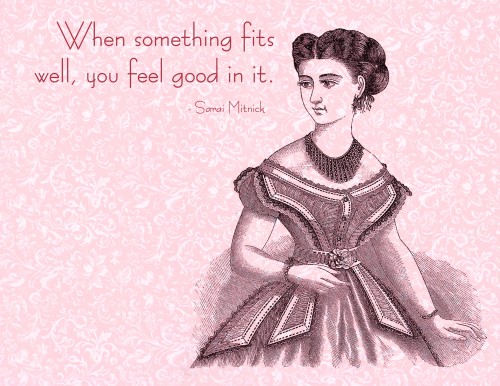Fantastic Fit
I may have used affiliate links for some of the items in this post. Using an affiliate link to purchase an item won't cost you any more money, but I may receive payment if you click on a link and make a purchase. For more information, visit the disclosures page.
I’ve been working my way through The Colette Sewing Handbook. In the first three chapters I learned several basic sewing techniques, how to determine what styles and patterns are right for me and how to read a pattern. I’ve made my own style sketch template (or croquis) and finished my first sewing project – the meringue skirt.
Now I’m moving on to working on fit. The best part of making your own clothes is to be able to create a custom fit, which is something that I’ve not known how to do before. In this chapter I’ve learned a lot about what makes a good fit.
Ease
The ease of a garment is the difference between the measurements of a person and the finished measurements of the garment. The amount of ease will vary my designer/manufacturer and type of design.
Fullness
The chapter also explained how darts (and several dart alternatives) work to effect the fullness and shape of a finished garment. They are most commonly used to fit the female form through the bust, abdomen, upper back, and derriere – yes the book says derriere. It does sound a lot classier than butt, doesn’t it?
Fitting Process
After explaining what makes a good fit, the book has some great instructions on how to do the fit.
- Know your measurements. If you don’t know them, how can you start with the right/closest size.
- Make a copy of your pattern. By working with a copy of your pattern on something a little more stable than tissue paper, you will more easily be able to make changes to the pattern pieces – and you can always start back at the beginning if you really mess things up. (I’m totally thinking ahead on this one).
- Make a mockup (or muslin). Making a version of your project in an inexpensive fabric first will give you the opportunity to see where changes need to be made in your pattern.
- Make changes to your pattern, as necessary.
That’s a lot of great information – but how do I make those changes to my pattern? There are great instruction with diagrams for the next several pages. It actually makes it look simple, except for a fullness alteration. I’m just going to hope that the bust size fits right off. It’s an alteration I hope not to have to make.
Have you ever altered a pattern? What was the most difficult part of the process for you?


I have. Once you do a couple, it’ll be easy. Just don’t rush through the first one. You can do it! 🙂
Thanks! I’m pretty sure you saw me working on the project that goes with this chapter a couple weeks ago. It’s going to be posted to the blog next week. I didn’t end up having to do too many alterations to the pattern, but I did end up having to cut different sizes for the skirt and bodice.